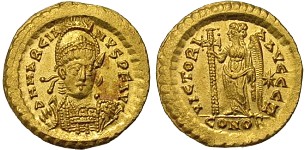Fine Coins Showcase
Antiquities Showcase
Show Empty Categories
Shop Search
Shopping Cart
My FORVM
Contact Us
About Forum
Shopping at Forum
Our Guarantee
Payment Options
Shipping Options & Fees
Privacy & Security
Forum Staff
Selling Your Coins
Identifying Your Coin
FAQs
zoom.asp
Home ▸ Catalog ▸ |Roman Coins| ▸ |The Late Empire| ▸ |Marcian||View Options:   | | | | | | Marcian was selected by Pulcheria to be the successor of her brother, Theodosius II. Marcian is described favorably by Eastern Roman and Byzantine sources, often compared to Emperors Constantine I and Theodosius I. His reign was seen by many later Byzantine writers, such as Theophanes the Confessor, as a golden age: Marcian secured the Eastern Empire both politically and financially, set an orthodox religious line that future emperors would follow, and stabilized the capital city politically. Some later scholars attribute his success not just to his skill, but also to a large degree of luck: not only had he been fortunate enough to have Pulcheria to legitimize his rule, for much of his rule the two greatest external threats to Rome, Persia and the Huns, were absorbed with their own internal problems; additionally, no natural disasters or plagues occurred during his reign. He was remembered fondly by the people of Constantinople, who would shout "Reign like Marcian!" at the installation of future emperors. |


To repudiate the Second Council of Ephesus, Marcian convened the Council of Chalcedon, the fourth council of the early church, in 451. Pulcheria may have made the convention a requirement during her negotiations to marry Marcian. about 370 bishops attended, most Eastern, but four were sent by Pope Leo I. This council reversed the decision of the Second Council of Ephesus that Jesus had one divine united nature, and instead agreed that Jesus had "a divine nature (physis) and a human nature, united in one person (hypostasis), with neither division nor confusion." The council also condemned Pope Dioscorus I of Alexandria, who had overseen the Second Council of Ephesus. The council repeated the importance of the See of Constantinople, giving it the right to appoint bishops in the East, over the objection of Pope Leo I. Marcian issued edicts confirming the decisions. One edict ordered the repression of Eutychianists, barring them from holding state offices, forbidding them from criticizing the Council of Chalcedon, and ordering their literature, alongside that of the Nestorians, to be burned. The result was numerous violent religious revolts which Marcian suppressed with military force. A large number of Christians who disagreed migrated to the Sassanid Empire.MA113867. Bronze half centenionalis, cf. SRCV V 21393 ff. (various mints), aF, green patina, porous/rough, weight 1.065 g, maximum diameter 11.4 mm, die axis 0o, uncertain mint, obverse D N MARCIANVS P F AVG, pearl-diademed, draped, and cuirassed bust right; reverse Marcian monogram (RIC monogram 1)


SH37574. Gold solidus, DOCLR 481 (also 7th officina), Ratto 217, RIC X Marcian 510, Hahn MIB 5, SRCV V 21379, EF, weight 4.485 g, maximum diameter 20.9 mm, die axis 180o, 7th officina, Constantinople (Istanbul, Turkey) mint, c. 450 A.D.; obverse D N MARCIA-NVS P F AVG, diademed, helmeted and cuirassed bust facing, holding spear and shield decorated with horseman spearing a fallen enemy; reverse VICTORIA AVGGG Z (victory of the three emperors, 7th officina), Victory standing left holding a long jeweled cross, star in right field, CONOB in exergue; scarce; SOLD


At the beginning of Marcian's reign, the Eastern Roman treasury was almost bankrupt, due to the huge tributes paid to Attila by Theodosius. Marcian reversed this near bankruptcy not by levying new taxes, but rather by cutting expenditures. Upon his accession, he declared a remission of all debts owed to the state. Marcian attempted to improve the efficiency of the state in multiple ways, such as mandating that the praetorship must be given to senators residing in Constantinople, attempted to curb the practice of selling administrative offices, and decreed that consuls would be responsible for the maintenance of Constantinople's aqueducts. He repealed the Follis, a tax on senators' property which amounted to seven pounds of gold per year. Marcian removed the financial responsibilities of the consuls and praetors, who had since the time of the Roman Republic been responsible for funding the public sports games or giving wealth to the citizens of Constantinople, respectively; additionally, he made it such that only the Vir illustris could hold either office. By the time of his death, Marcian's shrewd cutting of expenditures and avoidance of large-scale wars left the Eastern Roman treasury with a surplus of 100,000 pounds (45,000 kg) of gold.SH18897. Gold solidus, DOCLR 481 (also 7th officina), Ratto 217, RIC X Marcian 510, Hahn MIB 5, SRCV V 21379, Choice aMS, nice strike, tiny scratch on reverse at Victory's right hip,, weight 4.476 g, maximum diameter 20.9 mm, die axis 180o, 7th officina, Constantinople (Istanbul, Turkey) mint, obverse D N MARCIA-NVS P F AV, diademed (with jewel), helmeted, and cuirassed bust facing slightly right, holds spear and shield; reverse VICTORI-A AVCCC Z (victory of the three emperors, 7th officina), Victory standing facing, head left, holds a long jeweled cross which rests on ground, star right, CONOB in exergue; the officina appears to have been recut, from a die for the 10th officina (I); scarce; SOLD
CLICK HERE TO SEE MORE FROM THIS CATEGORY - FORVM's PRIOR SALES



OBVERSE| LEGENDS|
REFERENCES|
Page created in 0.61 seconds.








